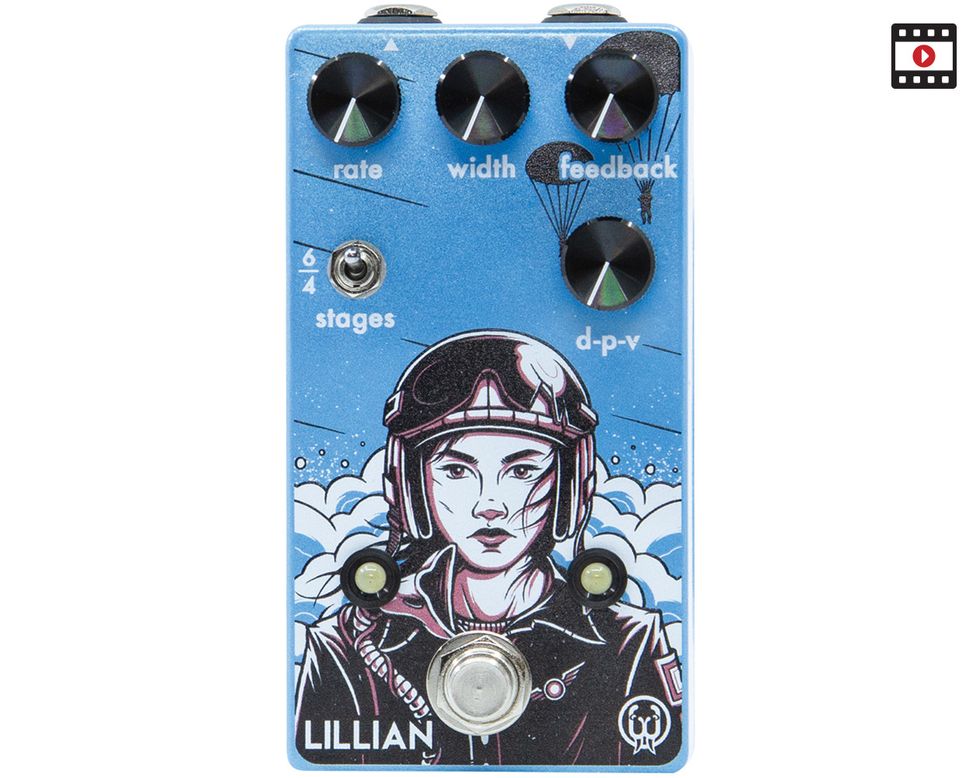RatingsPros:Expansive phase-crafting control. High-mid bump helps phase cut through at all stages of sweep. Intuitive, responsive controls invite experimentation. Cons: High-mid-forward voice can sound less natural and gooey than vintage phasers. Street: $199 Walrus Audio Lillian walrusaudio.com | Tones: Ease of Use: Build/Design: Value: |
The average guitarist probably doesn’t regard phase as a subtle effect. Some players, in fact, might well ask what the point of subtle phase could possibly be. But phase is, in fact, quite effective when used in mellow, less-than-peak-hallucination situations.
Any Small Stone or Phase 90 devotee can tell you that there aren’t many options for mellowing a vintage phaser. Mixing a phased guitar track down in the studio will typically obscure everything but the peaks. That’s a cool sound in some settings, but it can also sound downright wishy-washy and superfluous. What’s cool about Walrus Audio’s Lillian analog phaser is the ease with which you can move between extremely subtle, almost subliminal, phase textures and trippier swirls with ease—thanks to a very cool effect blend control and a rate control that ranges to uncommonly slow rates.
Modulation Mojo Navigator
Most phasers are stupidly simple. The one-knob MXR Phase 90 must be at least tied for the distinction of easiest-to-use of all time. And while the Lillian offers many more phase-crafting options than a Phase 90 or Small Stone, it’s still very simple, super-intuitive, responsive, and inviting at the tactile level. The rate, width, and feedback controls have great sensitivity, precision, and range that makes subtle adjustments easy to dial in and hold.
The Lillian’s fourth knob, the dry/phase/vibrato control, is the real key to the device’s versatility. It uses digital control to move smoothly between phase-free signal flow to intense 50/50 wet/dry phase mixes at the noon position, and wobblier, all-wet, vibrato-inflected phase at the full-clockwise position. There are many cool blends in the spaces in between, too.
The Lillian certainly isn’t the first phaser with a mix control. And the phase/vibrato relationship dates back as far back as old Magnatone amplifiers and the Uni-Vibe. But this blend control, like the other controls on the Lillian, has satisfying sensitivity and interesting grey areas that make it fun to zero in on very specific and often unique phase textures.
The only other control is the 6/4-stage toggle switch, which adds an extra two stages of thickening phase in the 6 position. The soft-relay footswitch, however, does conceal one cool surprise: It can be held down for momentary activation of the phaser—a useful and expressive tool that might find you situating the Lillian in a more accessible place on your pedalboard.
The quality implied by the smooth, precise knobs is evident elsewhere in the Lillian’s construction. The printed circuit is machine populated and power and I/O jacks are board-mounted rather than affixed to the chassis. Such design decisions might be worrisome if you use the Lillian away from the safety of a pedalboard, where kicking, stomping, and bumping injuries from overzealous or clumsy bandmates become commonplace. But on the whole, it feels like a robust build.
Fly the Swirly Skies
In a general sense, the Lillian’s voice seems ever-so-slightly geared toward contemporary production settings. There’s a sometimes slight but perceptible bump in high-mid and top-end presence compared to vintage 4-stage phasers like the Small Stone and Phase 90. And there’s lot of flexibility to tailor those wave forms to stand out in high-mid-range-forward productions. That said, there are myriad ways to situate the Lillian in the shadier corners of a mix, and that is the real beauty of the unit.
For starters, the rate can be set to preposterously slow speeds that remain present, but verge on undetectable until the wave peak starts to reappear. And you can use the blend knob, width, and feedback to dial in ideal orientations with other instruments. Looping a clean rhythm track, adding phase from the Lillian, and manipulating these controls at hyper-slow rates gives you a great feel for how the Lillian’s subtle animation can enliven a very basic passage without adding phase in cartoonish doses. Vibrato-heavy settings at these slow rates sound especially cool and unusual—adding trace elements of queasy pitch shift at mildly aggressive width and feedback levels. Such subtlety can be explored at faster rates, too. I loved speedier rates with the feedback, width, and wet/dry mix dialed way back. And though these settings, along with the high-mid-forward voice, can make the Lillian feel less than seamlessly integrated with your instrument tone, it’s still a very effective way to add tasteful doses of motion without overwhelming a song.
The Lillian’s extreme sounds are cool, too. High width settings tend to induce a very peaky and intense pulse in the modulations—especially in 6-stage mode and at high feedback levels. This setting can be used as a unique substitution for tremolo in many contexts.
The Lillian’s weak spots are few and largely subjective. For instance, the pedal’s high-end-forward voice offsets some of the perceived sensation of volume drop that phaser users tend to complain about. But you do sacrifice some of the thick, molasses-y, swirl that you hear in an old Small Stone or Phase 90. There’s also nothing quite as wildly psychedelic and chewy as a Small Stone’s “color” mode available among the Lillian’s many phase-crafting options. Whether these qualities are positives or negatives in your phaser worldview is largely down to personal taste.
The Verdict
The Lillian is a distinctly modern phaser. Its basic voice is bright, it offers very precise levels of control, and it readily cuts through the morass of multiple effects. To achieve these advantages, it sacrifices some of the smooth depth and dimensionality of a Small Stone or Phase 90. For many players, though, the Lillian’s phase-crafting options, presence, and flexibility will make the trade-off worthwhile.
Watch the First Look:








![Rig Rundown: Russian Circles’ Mike Sullivan [2025]](https://www.premierguitar.com/media-library/youtube.jpg?id=62303631&width=1245&height=700&quality=70&coordinates=0%2C0%2C0%2C0)

















